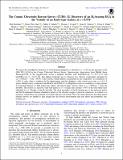The Cosmic Ultraviolet Baryon Survey (CUBS). II. Discovery of an H 2 -bearing DLA in the Vicinity of an Early-type Galaxy at z = 0.576*
Author(s)
Boettcher, Erin; Chen, Hsiao-Wen; Zahedy, Fakhri S; Cooper, Thomas J; Johnson, Sean D; Rudie, Gwen C; Chen, Mandy C; Petitjean, Patrick; Cantalupo, Sebastiano; Cooksey, Kathy L; Faucher-Giguère, Claude-André; Greene, Jenny E; Lopez, Sebastian; Mulchaey, John S; Penton, Steven V; Putman, Mary E; Rafelski, Marc; Rauch, Michael; Schaye, Joop; Simcoe, Robert A; Walth, Gregory L; ... Show more Show less
DownloadPublished version (4.205Mb)
Publisher Policy
Publisher Policy
Article is made available in accordance with the publisher's policy and may be subject to US copyright law. Please refer to the publisher's site for terms of use.
Terms of use
Metadata
Show full item recordAbstract
We report the serendipitous detection of an H2-bearing damped Lyα absorber at z = 0.576 in the spectrum of the QSO J0111–0316 in the Cosmic Ultraviolet Baryon Survey. Spectroscopic observations from Hubble Space Telescope-COS in the far-ultraviolet reveal a damped absorber with log[N(H i)/cm−2] = 20.1 ± 0.2 and log[N(H2)/cm−2] $={18.97}_{-0.06}^{+0.05}$. The diffuse molecular gas is found in two velocity components separated by Δ ν ≈ 60 km s−1, with >99.9% of the total H2 column density concentrated in one component. At a metallicity of ≈50% of solar, there is evidence for Fe enhancement and dust depletion, with a dust-to-gas ratio κO ≈ 0.4. A galaxy redshift survey conducted with IMACS and LDSS-3C on Magellan reveals an overdensity of nine galaxies at projected distance d ≤ 600 proper kpc (pkpc) and line-of-sight velocity offset Δ νg ≤ 300 km s−1 from the absorber. The closest is a massive, early-type galaxy at d = 41 pkpc that contains ≈70% of the total stellar mass identified at d ≤ 310 pkpc of the H2 absorber. The close proximity of the H2-bearing gas to the quiescent galaxy and the Fe-enhanced chemical abundance pattern of the absorber suggest a physical connection, in contrast to a picture in which DLAs are primarily associated with gas-rich dwarfs. This case study illustrates that deep galaxy redshift surveys are needed to gain insight into the diverse environments that host dense and potentially star-forming gas.
Date issued
2021Department
MIT Kavli Institute for Astrophysics and Space ResearchJournal
Astrophysical Journal
Publisher
American Astronomical Society
Citation
Boettcher, Erin, Chen, Hsiao-Wen, Zahedy, Fakhri S, Cooper, Thomas J, Johnson, Sean D et al. 2021. "The Cosmic Ultraviolet Baryon Survey (CUBS). II. Discovery of an H 2 -bearing DLA in the Vicinity of an Early-type Galaxy at z = 0.576*." Astrophysical Journal, 913 (1).
Version: Final published version